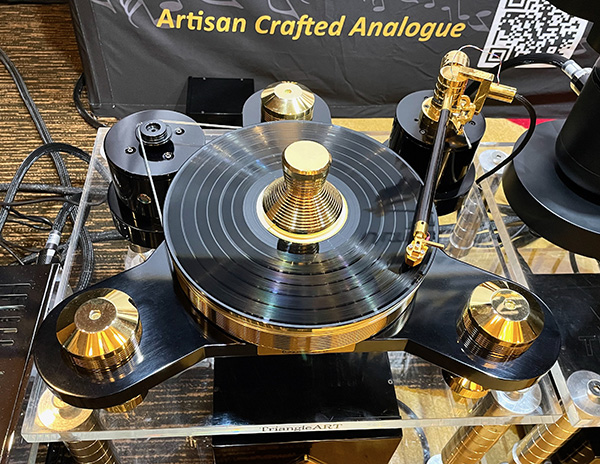| Columns Retired Columns & Blogs |
No cable lifters, so differences and sonic nuance would be too osbcured to really be able to tell.

To set the stage, I'll note that the system was Triangle Art from top to bottom. The electronics included the $18,000 P200 phono stage, $25,000 L200 Mk2 dual-mono preamplifier, and a pair of $25,000 M100 monoblock amplifiers. The system also included a $12,000 RA Ultimate Power Conditioner and an assemblage of power and signal cables that ranged from $3000 to $12,000. Last but not least, the loudspeakers were the $60,000/pair Metis.

The three turntables I was checking out were the $9,000 Maestro, $18,000 Anubis, and $130,000 Ultimate SE. All were fitted with 12" tonearms. The Maestro was fitted with a $4400 Horus, and $4800 Zeus MC cartridge; and both the Orion and Ultimate SE had a $9000 Osiris Mk2 arm and $9000 Apollo MC cartridge.

I chatted with Triangle Art's Lead Designer, Tom Vu and listened to LPs for about an hour, trying to home in on the turntables' sounds. I'll note up front that the differences I heard between the Maestro and the Anubis were far smaller than those between either one and the Ultimate SE. The overt differences between the Ultimate SE and the two less expensive models were pretty much what I'd expected—more bass extension and a noticeably better reproduction of the tonal and harmonic content of bass notes; more precise spatial and temporal transients, and a dramatic increase in the amount of low-level detail.
After listening to the Ultimate SE, it was pretty hard to be certain about any differences I heard between the Anubis and Maestro, especially since they were fitted with different arm/cartridge combos. For whatever it's worth, the single cut that I found most engaging during my hour of listening was a performance of "Jazz Me Blues" by Art Pepper on Contemporary Records—played on the Anubis, Osiris, and Zeus combination. Go figure.

No cable lifters, so differences and sonic nuance would be too osbcured to really be able to tell.